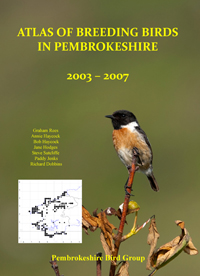Breeding summer visitor and passage migrant. Not recorded from December to March
The Grasshopper Warbler was a summer visitor with a local breeding distribution to both Mathew (1894) and Lockley et al. (1949), the latter noting that it was a scarce passage migrant on the islands in spring but had only once been recorded in autumn.
Now they are regular in spring between 7 April and early June, sometimes occurring in considerable numbers on the headlands. They sing from cover but also from exposed perches, and up to 40 have been recorded in a day at Skokholm.
Grasshopper Warblers are still locally distributed (see map), occupying patches of rank growth such as fen, common and scrubby grassland, a commodity that has diminished during the years with the development of intensive farming. They also nest in young conifer plantations including those at Wiston Wood and Pantmaenog Forest. The number occupying suitable habitat varies according to how they fare on migration and in their sub-Saharan winter quarters. On the evidence found during the Breeding Birds Survey of 1984-1988 an average density of four pairs per tetrad, based on singing birds, suggests a total population in Pembrokeshire of 400 pairs. However, this is almost certainly an underestimate.
Grasshopper Warblers are less numerous in autumn than they are in spring, with small numbers passing through coastal areas between 27 July and 21 October. One was recorded at Skokholm on 7 November 1968.

Fieldwork 1984-88 (based on 478 tetrads)
Red = breeding confirmed = 8
Orange = breeding probable = 70
Yellow = breeding possible = 11
Total tetrads in which registered = 89 (18.6%)
Donovan J.W. & Rees G.H (1994), Birds of Pembrokeshire
 Friday, August 9, 2013 at 7:45AM
Friday, August 9, 2013 at 7:45AM 




